Water, water, everywhere…
Camping in the backwoods or traveling through Mexico means you’ll need clean drinking water all day, every day. Even if you’re surrounded by enough civilization that bottled water is readily and cheaply available, it doesn’t hurt to have a portable water filter or purifier for those days when all the stores are closed, or you’re too lazy to go outside, or you see someone filling up empty water bottles from the tap to be resold in stores again. Ew.
Luckily for all of us, portable water filters have actually gotten pretty great recently. And no, I’m not talking about the well-known options that have great marketing and cost hundreds of dollars and don’t filter out viruses dammit. Why do they cost so much if they still let bugs through that’ll kill me!? Argh!
The options I’m talking about are comprehensive filtration devices, with technology so good that they’ll handle even the tiniest of microscopic organisms, which most traditional backpacking filters can’t handle. You can fill up from a stagnant pond in sub-Saharan Africa and you’ll be just fine. And isn’t that lovely?
What kind of water filter or purifier do I need?

This is where it starts getting technical, but the way I look at it, there are three major categories of contaminants worth discussing:
- Chemical: Lead, arsenic, chlorine, and iodine come to mind. These are more often found in tap water than river water, so if you’re traveling abroad (or filtering at home), you’d want something that can help with these. Dirt and dust are important to remove as well, but pretty much every filter on the market will do that. I’m not aware of anything that’ll filter out all chemicals, but carbon filtration is the most common method for handling these, and is quite helpful.
- Bacterial (and bacterially-sized things): These are the most common biological contaminants, and the most important things to filter, whether you’re traveling to another country, or hiking in your own. There are other microorganisms out there that can cause illnesses (such as protozoan cysts, like giardia and cryptosporidium), but they’re similarly sized, so if a filter can handle bacteria, they can handle the other ones too.
- Viral: Viruses, the smallest organisms on earth, bypass most filters. Viruses are pretty rare, and generally only found in rural environments in developing countries. You probably don’t need viral filtration if you’re hiking through North America or Western Europe (which is part of the reason why filters that remove viruses are so rare), but…well, if it can do it, great.
Ideally, you’d want something that can handle all three, and that’s what this list is about. To the best of my knowledge, these are the best portable water purifiers on the market today. Significantly cheaper options exist, they won’t work nearly as well as these.
This list is split into two parts, starting with…
Part 1: If you need total filtration (including viruses)
The following devices offer all-in-one filtration, including large dirt particles, harmful chemicals, bacteria and bacterially-sized microorganisms (like cysts and giardia), and viruses. If you’re going to remote areas in developing countries, viral filtration is important; if you’re hiking around North America or filtering tap water in Western Europe, you probably don’t.
There are certain things they won’t remove (salt, for example), but the options listed here offer the most comprehensive filtration on the market, and you probably won’t find something that does. These will remove all harmful biological contaminants, and certain chemicals, making tap water or river water taste great, and safe to drink.
1) Lifesaver Bottle: $150
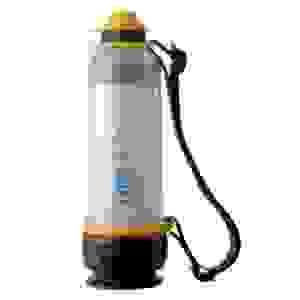
Update: It looks like the Lifesaver will be discontinued. I’m not entirely sure if this is temporary, but I’ll keep this updated if things change.
The Lifesaver Bottle was designed for the developing world, featuring an all-in-one portable water purifier that could provide clean drinking water for the 3 billion people that need it at a total investment of $20 billion. Makes you want to donate, doesn’t it?
As its design goals were simplicity and cost-effectiveness, it happens to suit the needs of backpackers and hikers just as well, and is readily available for purchase by first-world consumers, who are encouraged to participate in a buy-one, donate-one program.
The bottle has a filtration and pump system housed entirely within the bottle, so you pump a few times to press the water through the super-fine filter, and then you can drink. The bottle has a watertight cap, a carrying strap, has completely replaceable parts, and can even handle viruses.
For a while the Lifesaver was far and away the most cost-effective option on the market, though a couple new options have emerged that are lighter, don’t require pumping, and don’t need to be submerged upside down in a river to fill it up, like the Lifesaver does; but it’s still quite good.
The following numbers are estimates for the $150 Lifesaver Bottle 4000, with a limit of 4000 liters, and assume high-frequency replacement of carbon filters, available in $30 packs of 4 which treat 250 liters each. The 6000 liter version and carbon filter value packs can reduce the long-term costs listed below by about half.
- Unit price: $150 (4000 liter version)
- Replacement parts: $100 per cartridge, $8 per carbon filter, $6 per pre-filter
- Lifespan: 4000 liters (carbon filters need more frequent replacement)
- Initial water treatment cost: $0.06 per liter
- Recurring water treatment cost (replacement cartridges + filters): $0.05 per liter
- Empty weight: 22 ounces (623 grams)
Buy it here.
2) The Grayl Ultralight: $60
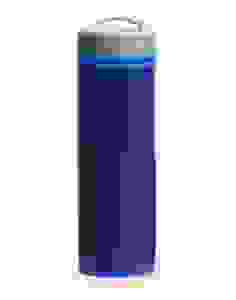
Frequently referred to as the Holy Grail of water purifiers (doesn’t everyone love puns?) the Grayl was designed by someone who got tired of drinking from sporty bottles with gigantic logos and flashy colors. This one offers the same great filtration performance as anything else you’ll find, but without the need for pumping, sucking, squeezing, or waiting.
The filter mechanism works like a French press; you fill up the lower chamber, and press the upper unit down into it. It takes about 15 seconds, after which you can drink just like you would from a regular bottle, without having to suck up the water through a straw. It also means you can pour out purified water into a cup for a friend, or fill up spare bottles for a long trip, and you’ll be hauling clean water around with you, instead of dirty water.
The Grayl has multiple filter unit options which can be swapped out according to your needs, including a low-cost tap water filter, or the top-of-the-line Purifier cartridge, which can handle viruses (removing 99.9999% of them), and 99.9999% of bacteria, along with other microorganisms and chemicals, with a 150 liter lifespan. From what I have seen, its filtration quality is the best of anything on this list.
The numbers below are for the Purifier cartridge, which is what you’d want for outdoor backpacking or international travel.
Full disclosure: They’ve provided me with some free test samples, and, years after the reviews, made me a revenue-sharing offer as well. But I like it a lot. Check out a very in-depth review here.
- Unit price: $60
- Replacement parts: $25 per cartridge (Purifier)
- Lifespan: 150 liters
- Initial water treatment cost: $0.40/liter
- Recurring water treatment cost (top-of-the-line Purifier unit): $0.16/liter
- Empty weight: 10.9 ounces (309 grams)
Buy it from TheGrayl.com.
3) Aquamira Frontier Bottle (Red Line): $50
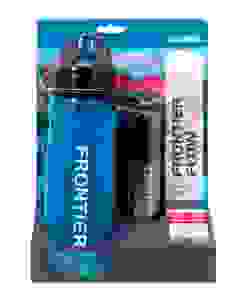
This is a recent upgrade to a previous Aquamira bottle; the new ones adds viral protection (in addition to chemical and bacterial and other microorganisms), making it seriously effective anywhere in the world.
Because it’s a recent modification to the Aquamira lineup, you’ll need to make sure it specifies viral protection (if that’s what you need, of course), and the replacement filters will be labelled Red Line. The bottle has other replacement filters, such as Green Line, but that’s for non-viral filtration (good for hiking in North America, and significantly cheaper, so it’s useful that you can swap them out as needed).
The numbers listed here are for the Red Line filter, to provide a direct cost comparison with the other top-of-the-line filters listed here, and the numbers are pretty great. It removes chemicals, 99.9999% of bacteria, and 99.999% of viruses and other microorganisms, with a 450 liter lifespan. The squishy straw is the type of thing that might need to be cleaned out every once in a while, but that’s true of most bottles anyway.
Full disclosure: The manufacturer has provided me with a few test products (though not this particular item), but all these numbers are accurate.
- Unit price: $50
- Replacement parts: $40 per cartridge (Red Line filter)
- Lifespan: 450 liters
- Initial water treatment cost: $0.11 per liter
- Recurring water treatment cost (cartridges): $0.08 per liter
- Empty weight: 5.6 ounces (158 grams)
Get it here.
They also make an in-line filter for attaching to a hydration bladder hose, which offers the same virus-removing performance, and is (at the moment) the only one I know of that does that.
4) Water to Go Bottle: $40 (approximately)
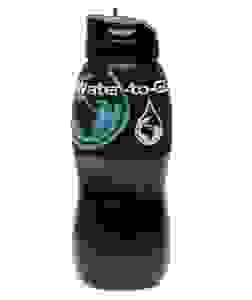
This is another one that might require overseas shipping, depending on where you live, but even with British pound conversion and international shipping costs, it’s still rather affordable.
The Water to Go Bottle removes 99.9% of biological contaminants (including viruses) and certain harmful chemicals, using a NASA-developed technology that removes particles from the water without using a “real” filter, but through a process called adsorption, though it also includes a carbon component for soaking up chemicals.
(The site claims it removes 99.9% of all microbiological contaminants, but elsewhere on the site they’ve listed the test results, which put both virus and bacterial removal at 99.9999%, and other types at 99.99%. I’m not sure what the 99.9% refers to.)
There’s a smaller bottle available as well, but the numbers here are for the one in the photo. Prices on their site are listed in British pounds, and the numbers here assume a conversion rate of 1 British pound equal to 1.5 American dollars, and don’t take into consideration the international shipping costs:
- Unit price: $37.50
- Replacement parts: $13.5 per cartridge
- Lifespan: 200 liters
- Initial water treatment cost: $0.18 per liter
- Recurring water treatment cost (cartridges): $0.067 per liter
- Empty weight: 4.8 ounces (138 grams)
Get it here.
5) Katadyn MyBottle: $60
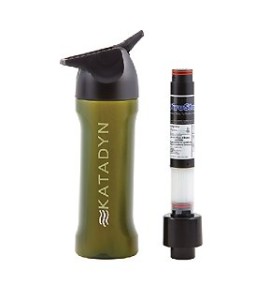
The Katadyn MyBottle uses a combination of filtration and iodine purification, to remove particles, and kill whatever microorganisms are inside. This is highly effective, but means the water will taste like iodine. This used to be the standard method for hikers everywhere, but some of the newer models, such as those listed above, manage the same level of safety without any added chemicals, which is likely to be a preferable solution for most people.
But it works, so I’m including it here, as it came in quite handy for me on trips through Eastern Europe and South America, and it’s quite simple. Besides, I don’t think it tasted so bad. I think it has been bested by some of the newer models out there, both in terms of non-iodine performance and cost-effectiveness, but it’s still quite functional, particularly if you use it only occasionally, in which case its moderately-cost-effective performance won’t add up too much.
- Unit price: $60
- Replacement parts: $35 per cartridge
- Lifespan: 150 liters
- Initial water treatment cost: $0.40 per liter
- Recurring water treatment cost (cartridges): $0.23 per liter
- Empty weight: 10 ounces (283 grams)
Buy it here.
If you DON’T need total purification
So this probably sounds horrifying, but there are a couple systems worth mentioning that only provide partial filtration, specifically focusing on removing biological contamination, which is the type of thing that works perfectly fine for hikers, but is not necessarily ideal for travelers, who will run into metallic tap water and maybe a virus or two. But if you’re hiking in North America, these might work for you:
7) SteriPEN Water Purifier systems: $100 (depending on the model)
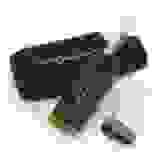
Although I much prefer all-in-one systems contained within the bottle, this is a popular device for backpackers all over the world, so I thought I’d discuss it here.
The important thing to remember is that the SteriPEN kills the microorganisms in the water with UV light, but does not actually remove them; it’ll be safe, but you’ll drink them right up. This also means it won’t remove chemicals, metals, particles, or anything else.
It’s possible to combine this with extremely cheap carbon filter bottles, which only remove large particles and certain chemicals, and thus combining them together would provide a more complete system. The Camelbak Groove and Brita water bottles come to mind.
You also need to use clear water, because the UV light will get blocked by sediment. You really don’t want to use this on muddy water, ever. You don’t want to use any filter with muddy water, but the other filters will actually clean it, which will damage the lifespan of the filter, but drinking muddy water with a SteriPEN might damage the lifespan of you.
The SteriPEN claims battery life long enough to clean 100 liters with 4 AA lithium batteries (about $2 each), which could be even cheaper with rechargeables (seriously, why does no one use rechargeable batteries?). The manufacturer will replace the bulb for $60, so the combined cost is still fairly cost-effective over long periods, but again, you’d need a separate filter if you wanted to remove metals, chemicals, and other stuff.
- Unit price: $100
- Replacement parts: $60 bulb, batteries of varying cost
- Lifespan: Approximately 8,000 liters (bulb lifespan)
- Initial water treatment cost (SteriPEN + 4 AA lithium batteries): $1.08 per liter
- Recurring water treatment cost (batteries + bulbs): $0.10 per liter
- Weight: 4 to 8 ounces with batteries, depending on the model (115 to 230 grams)
Buy it here.
8) The Sawyer Filter Bottle: $50
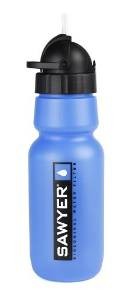
I have pointed out on many occasions that if you are only hiking in North America (and other places where viruses aren’t a problem), this is probably the best option out there.
The Sawyer bottle has a 0.1 micron filter size, which is good for everything biological except viruses, and it won’t handle chemicals, either, so it’s no good for low-quality tap water; but it’ll handle 99.99999% of bacteria, along with other bacterially-sized microorganisms (cysts, protozoa, etc), which works just fine for filling up from a river in the mountains, and is guaranteed to last for 3.7 million liters (minor note: these claims have been put to the test, and have been shown to come up short; it’s probably best to replace the filter long before the lifespan guarantee runs out).
There’s the arguable advantage of having something all-in-one, which can handle hiking and international travel and icky tap water, and some people might prefer that sort of minimalism; but if all you need is something for outdoorsy North American recreation, this is a good one.
- Unit price: $50 (though frequently found on sale)
- Replacement parts: None; buy the whole thing again
- Lifespan: 3.7 million liters (as mentioned, this claim is not sufficiently backed with evidence; it’s probably best to use it for a few months, just like the others)
- Initial water treatment cost: $0.000013/liter
- Recurring water treatment cost: $0.000013 per liter (as mentioned, it won’t last as long as they say, so this number should really be much higher)
- Weight: 5.5 ounces (155 grams)
Get it here.
There’s an in-line filter as well, for attaching to a hydration bladder, which offers the same performance.
Final thoughts
As you may have noticed, I’m a big fan of all-in-one designs. With the exception of specialized devices like the Sawyer Bottle and SteriPEN, all the options on this list can handle chemicals, bacteria and bacterially-sized things, and even those pesky little viruses (though with varying removal rates), though I would recommend using the ones with the highest removal rates if you’re going somewhere seriously questionable. Other pros and cons include some with great long-term cost-effectiveness, while others might offer swappable filters for low-grade filtration in less risky areas, and others might just fit better in your cup holder. A lot of this comes down to personal preference and ease of use, but performance is worth taking into consideration as well. But for reasons related to performance and ease of use, I’m sticking with the Grayl for now.

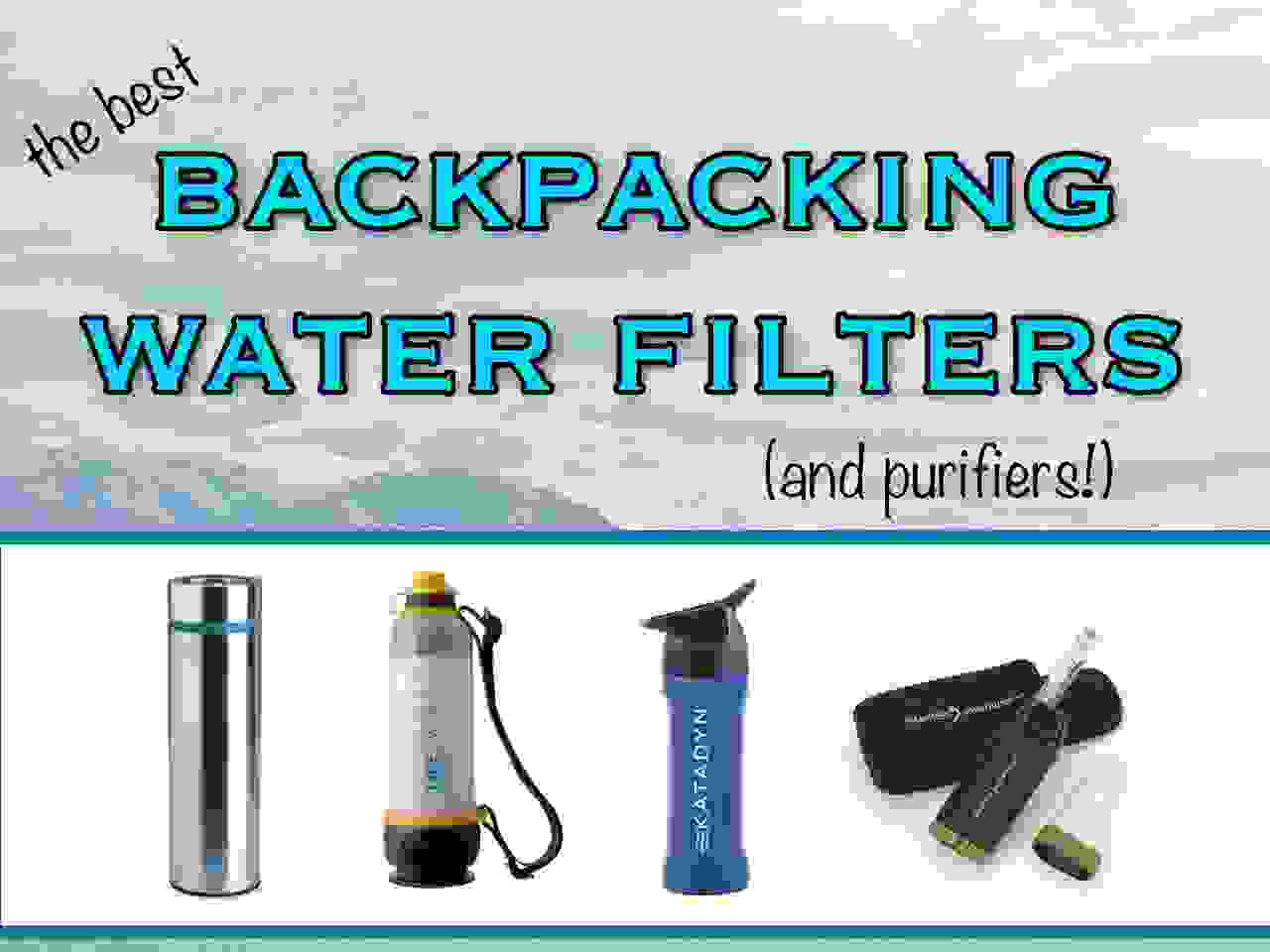



This is exactly what I have been looking for. Thank you for the great reviews and product descriptions! I need to get my hands on that DrinkSafe bottle ASAP
Hello,
I have read your review and it is very helpful,
but sadly I still can’t find a bottle that would help me reduce or completely remove to fluoride content in the tap water, since I wander around cities I use tap water rather than natural sources.
In your previous reply over here you said some one Brita is good enough for the cities but I have heard that it does not removes any fluoride content. I have seen only two companies even mentioning that they clean fluoride which are “Seychelle” and “Clearly Filtered” but they both had bad reviews on Amazon.
I did like “The Grayl” urban option since it looks reliable and it is also reviewed personally b you, you might know if it filters any fluoride content. Can you help me to pick a bottle for Urban option?
Grayl won’t filter enough fluoride (they say it removes some, but less than 30%, so it’s not enough for them to make the claim that it can handle the fluoride). They say it requires a different kind of technology to do it. It looks to me like the only options to remove fluoride are larger, and not so portable. I think you might have to go with bottled water if your goal is to remove fluoride (though it seems to me from what I’ve read that fluoride in small amounts is better for you than it is problematic).
I can’t speak for fluoride filtration, but I understand the concern. The whole point of fluoridation is to prevent tooth decay – and it’s more effective as a topical application. Toothpaste, for example. Putting it in water also helps with tooth strength, but consuming too much ends up messing up adult thyroid glands. (Plus most kids I’ve met don’t actually like to drink plain tap water except as a last resort.) I don’t try to avoid it myself, but I’m also not entirely thrilled about it being there.
Imagine my surprise when I got to Costa Rica last year and discovered they put fluoride in their table salt. Non-fluoridated salt was simply unavailable in shaker size at the local grocery store. Now THAT is all kinds of biologically and gastronomically wrong.
So… I can’t really answer the question about fluoride filtration. Just wanted to say I can easily understand why someone might want to know.
Personally, I was concerned about filtering chlorine and chloramines. Too many cities hyper-chlorinate like a cheap motel swimming pool, hoping it’ll overpower whatever germs floated downstream. The contact person at Grayl told me it’s effective against chlorine but they still needed to run tests on chloramines. It’s a improvement anyway…
Thank you for the replies for my concern. Now that I know I can’t do much to reduce fluoride content of the tap water with just filtered bottles, I am just looking for a cheaper option for tap water filtration for daily use. I think Naked filter would be the best option to me but it won’t be coming out until this later month. (I learned about nakedfilter from this webpage’s replies as well.) http://www.nakedfilter.com
I really wonder if nakedfilter is worth to wait for thou, since the filtration process of it seems so fast, very fast that it doesn’t look like it could remove chemicals (like chlorine) as good as Grayl (although the tap water option for Grayl needs 7 secs to press on it uses the force of pressure to do it that fast.)
The very last question on their FAQ page verifies that Naked doesn’t filter fluoride. I’m not sure of any that can do that, though. Fluoride has gotten a bad reputation in certain circles, but from all the research I’ve seen, it’s a net positive for the health of your teeth. The only time it does something bad is if you ingest huge amounts of it, which isn’t really possible with just drinking tap water. I know this isn’t enough info to close the door on the subject, but all the research I’ve seen says it’s a good thing.
I am going to Togo for 9 days and am unsure if I will have access to bottled water. My co-worker bought the Drink Rite Survival Water Bottle Filtration System. I was thinking of also purching it, thoughts, but am unsure if it is a good choice for all 3 filtering needs. Thoughts?
http://www.amazon.com/Filtration-Hydration-Eliminates-Waterborne-Parasites/dp/B00WW03QH0/ref=cm_cd_al_qh_dp_i
I would be extremely suspicious of the marketing claims there. It looks completely identical to the Lifestraw Go, but it says it can filter particles of 1/10th the size and with a 50% greater lifespan. It’s literally saying that it’s 15 times better, even though the design is clearly exactly the same thing. It may very well be that it’s good, but I doubt that it’s as good as it says.
I would look for something that filters viruses, if you’re going to Togo. This thing says it’ll handle things down to 0.01 microns, but I just plain don’t believe them (since the Lifestraw Go says it only goes to 0.2). Try to get something that explicitly says it’ll handle viruses, like the ones listed on this page.
Been online for three hours looking for an all in one water bottle. Prob go with the grayl cuz that’s how i roll. This is the best most readible resource ive found on this subject. subscribed. Any thoughts on the multi level puritti ariix bottle there’s some video of a guy drinking his piss out of it. Oh and could I drink my piss out of the grayl (hypothetically)?
That’s a new one for me, but the stats make it sound like it’s similar to the rest on this page, both in terms of filtration and lifespan. Looks like it would work just fine.
Not sure about drinking your own urine…there are probably some compounds in there that aren’t generally listed on product info pages. They mostly talk about bacteria, protozoa, and so on, but those are completely different problems from those found in urine, so they never mention any ability to deal with it. I’d try to avoid finding out the hard way…
Ya not too enthused to try but still curious
You would be fine to drink your own urine but i believe it would still have some residual flavor. Most of the nasties are big enough to get caught though. Again, as previously noted, I would advise against it. And definitely not another person’s!
Drinking urine-
If it is the last drink you are going to drink- ie. you are going to die of dehydration in the next hour or so and there is definitely no other source water you are going to come across – you can do it- but it will wreck your filter- you are basically trying to filter salts- so it will block up really quickly- it might seem ok at the time- but once the filter dries out a little- the salts crystals will form- expanding within the system- result- blocked media and broken filter if it is grayl or life saver or lifestraw- ie depth filtration or hollow fibre- which is about 95% of all personal water filters available
Drinking urine is always a very short term fix- and probably only worth doing if you are within 30 minutes of death from dehydration- even though this may shorten your 30 minute lifetime left by 15 minutes- as with reverse osmosis your kidneys require lots of clean water to filter out the salt out of your body- so if you don’t have clean water to drink afterwards don’t drink urine to start with
best thing is to avoid doing it all- looks great for showing off products a little but actually shows what you should not do! same with the filtering of cola products(sugar) other videos have been shown on you tube etc- what they don’t show is they have just wrecked their filter at a cost of 20 – 60 £ $- this is fine if the company they are they are testing it for has given them the product but most people with their hard earned cash do not realise they are about to through their money down the toilet
ya definately not worth wrecking a $40 filter. U talk about not drinking urine unless it’s a last case resort are u talking about plain cuz video i saw of guy using puritti bottle once filtered he said had no flavor or color so i imagine it cleaned it pretty good.
Hi Ben
he would have wrecked his filter- depending on how dehydrated he was, would depend how fast his filter would become useless- urine is basically salts- UREA with water being the carrier to get rid of it from your body-
the more dehydrated you are the more concentrated the salt and the less urine you pass- the more hydrated you are the more water you pass and the less salts per milliliter there are- but you have more urine so you will still wreck your filter
If it says not for SEA water! then it is not for urine either- unless you are carrying out an experiment they have already done – so you do not have to
UREA has been used in the manufacture of buttons for clothes for probably 100 years- before plastic ones- they are usually used for suit buttons- once you remove the water and it crystalises it turns into the hard plastic like material as described- buttons- so it will break this kind of filter- at some point
hope this answers your the question- even though a long answer- it should help to remember it
tx. good point about sea water. Ill have to check the info on the grayl bottle i bought and see if i can filter sea water with any of the filters
With regard to the Lifesaver bottle please note the warning issued about this product by the manufacturer on October 28, 2015 – http://www.lifesaversystems.com/documents/LIFESAVER_Warning.pdf – and the subsequent notice of the company being in administration – http://www.lifesaversystems.com/maintenance
Thanks for this post – really useful! There doesn’t seem to be much research out there on this topic so it’s great that you’ve compiled this.
I’m considering getting either a Water-to-Go or a DrinkSafe Travel Tap. However, I’ve also found another product – the Aquapure Traveller Bottle. Have you looked into that product at all? I can’t work out how it compares with the others. I would really value your opinion on this.
Thanks again,
Pete
Hmm…I can’t find specific info as to what percentage of viruses it removes. Sometimes a product will say 99.9%, others will say 99.9999%, and so on. The more 9s there are, the better. It’s not necessarily a deal-breaker, but kind of a weird thing to avoid mentioning.
Hmm you’re right – I can’t find this info either. I think I will just go for the TravelTap since there seem to be a lot of good tried and tested reviews out there.
Thanks again,
Pete
Aquapure Traveller test results for biological contaminants are published here: http://www.purehydration.com/cms/wp-content/uploads/2012/09/test_results_for_pure_hydration_report_from_LSHTM_september_2011.pdf
Do you have any advice on the Berkey water filtration bottles? Thanks. .
It seems fine, but the reviews aren’t particularly generous. People say it leaks, or that it’s too hard to get the water through the straw, and in the product description, at least on the Amazon page where I’m looking, it says it can be filled 640 times from a municipal water source, AKA tap water. That seems like kind of an odd lifespan claim if they’re telling you to use tap water that’s already filtered or treated somehow. It’s probably usable, but maybe not something to get excited about…
hi!
didn’t you have the DrinkSafe Systems eco bottle on here? (i can’t see it now).
i bought it a year ago and wasn’t happy with it in the end. the lid leaked, and when i sucked up water through the straw it had a very dodgy taste a couple of times. i’ve emailed them to say this, but so far no reply. did others have any negative experiences with this bottle or am i the only one?
A reader wrote me to let me know that they don’t actually remove viruses. They just say they do. I can only say I’m sorry for including it on this list in the first place, and it won’t be on here again, unless they can prove what they say is true.
No problem! it’s a great list that I have come back to again as i search for my alternative to the drinksafe bottle :)
Eytan, IV been reading your post repeatedly. One question maybe uv already answered. Does KATADYN MY BOTTLE total purifier, filter everything the same way as GRAYL LEGEND? I’m waiting desperatly for your reply!!!!
The Katadyn and Grayl are both great, but they work in different ways; the Grayl removes the particles, whereas the Katadyn uses a combination of filtration and iodine purification, so it removes most of the particles, and kills the rest. I think they’re both equally safe, but the Katadyn will make the water taste like iodine.
Ah! I just bought Grayl Legend & with shipping, it costed alot. I used to have KATADYN but it broke in just 1 fall. So I went for the Legend as opposed to Grayl Ultralight or KATADYN for that matter. But I suddenly had a feeling if I should have just bought katadyn as it would have been cheaper. Grayl is great but it filters only 300 times per filter and it’s not a lot considering I need something cost-effective for 1+years I will be spending in Peru. I’m still wondering if I should get a lifestraw for everyday use in Peru. What do you think?
Thank you so much for your prompt and helpful reply :)
The Katadyn bottle’s filter lasts about as long as the Grayl’s filter, so I’m not sure why one or the other would be different in that sense, unless the Katadyn you’re talking about is the pump filter…but that’s not what’s listed on this page. If you drink a liter per day, you’ll go through maybe 3 filter cartridges over the course of a year, although maybe add an extra one or two because it’s hot, and the higher altitude will make you thirsty. But some of the time you might be drinking juice, tea, and so on.
I’m not a fan of the Lifestraw. I find it awkward to use, and it won’t filter metals or viruses, whereas the Grayl and Katadyn can handle those too.
Eytan! Thank you so much. Now, it was a wakeup call to realise katadyn only lasts as long as Grayl does! I’m happy I went for Grayl over katadyn simply because it’s all Steel even if it is heavier. So, the only way to go about is to get extra filters!
I was thinking of lifestraw just to drink everyday water from the people’s drinking water supply, in the Amazon jungle. I’m thinking, they won’t have water with viruses to consume for themselves. But I can clean that, a little bit more when I’m consuming it. I’m not a fan of lifestraw too, but maybe it might help with the everyday drinking fron the drinking water supply. We do need to consume like 8liters a day!!!! :) ID consume at least 4-6liters while not trekking :)